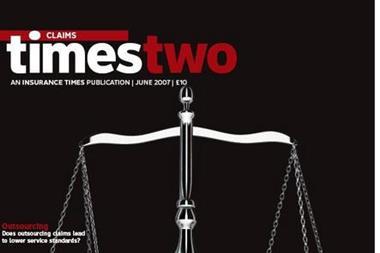The Motor Insurance Database has become a powerful tool for fighting crime, so brokers have a tremendous responsibility to provide accurate information fast, says John Hancock
Criminals tend not to insure their cars. Axiomatic, I know, but it illustrates just one benefit deriving from the motor insurance database (MID): among the most regular MID users are police forces, making one inquiry of the database every second.
But, the MID was not originally conceived as part of the fight against general crime. As Graeme Trudgill, technical services manager at Biba and a member of the Motor Insurers’ Bureau’s MID ‘Fitness for Purpose programme board’, puts it: “The MID’s prime focus is in combating uninsured driving although by helping to take uninsured vehicles off the road, it often helps to stop a lot of other crime.”
It was to address the specific problems arising from uninsured driving that the motor insurance industry first established the Motor Insurers’ Bureau in 1946 to handle compensation claims of victims in accidents where the faulty party was uninsured or untraceable.
Since the Road Traffic Act 1988, all insurers underwriting compulsory motor insurance have been compelled by law to join and pay towards the bureau.
So perhaps, given the financial implications (especially in the UK where 2 million uninsured drivers representing 5% of the total are eight to 10 times more likely to be involved in an accident costing the industry some £500m last year) it was inevitable that the bureau should establish the Motor Insurance Information Centre in 2000 to run a database on which all insured motorists could be listed with their policy details.
Now, with the introduction into the UK law of the Fourth EU Motor Directive requiring insurers of all UK vehicles to be traceable, the MID has taken on even greater significance as the compensation body under that Directive.
It is an offence not to have a vehicle insured and 60,000 uninsured vehicles were seized in the past year with 40% ‘ ‘ of those being subsequently destroyed.
With consequences like that, it is important that insurance details are current on the MID. The introduction of continuous insurance enforcement will allow police to compare data currently held on the MID with data held on the DVLA’s vehicle database, so making even more onerous the responsibility to update MID data.
While the law allows only seven days for all private motorist information to be updated on the MID, in the commercial lines market it allows 14 days for policy information and 21 days for vehicle information to be updated.
Overall there are 8 million updates each month to the 34 million vehicle records held on the MID.
Another consequence of the requirements is to create an imperative for speed in the processing of policies and changes so that they can appear on the database quickly to avoid even temporary inconvenience for motorists. This is seen by brokers as an advantage.
Peter Legg, director at Dorchester broker Arthur Savage Insurance, says: “The MID offers peace of mind for our clients by establishing the other party’s [in an accident] insurance details, but doesn’t really speed up the claim.”
Other than that, the benefits for brokers are often more in the shared credit for a better overall motor insurance system than specifically in the broker/policyholder relationship.
Colin Carter, director at Wickford broker Gardners Insurance Services, says: “Its more efficient for our customers with manually issued policies because they are issued more quickly.
“The MID offers peace of mind for our clients by establishing the other party’s [in an accident] insurance details but doesn’t really speed up the claim.
Peter Legg, Arthur Savage Insurance
“Although insurers have no time obligation to issue a policy, by the time the MID update requirement has been completed, most of the issue process will also be complete.”
This speed should also reduce work for broker office staff. It also suggests an added value service that brokers can offer in ensuring that private motorist clients supply their vehicle details in good time for the insurer to make a full update of the MID. They can also offer a service for commercial clients to handle their submissions to the MID, although clients will still need to supply their information in good time.
Ashton West, group chief executive of the Motor Insurers Bureau, says: “It is not uncommon at the time of a crash for the other party to provide insufficient details at the roadside to enable the innocent party to process a claim.
“Accessing the MID can therefore accelerate the claim process.
“The MID has improved the claims process and added value in terms of keeping the costs of claims down. During 2006 there was a 4.7% decrease in the number of claims reported to the bureau.
“The downward trend is encouraging, but more needs to be done to stamp out uninsured driving. Uninsured drivers are selfish in the extreme and they are often involved in serious crashes resulting in catastrophic injuries and sometimes the death of innocent victims.”
On the other side of the coin, one concern is that different insurers have different ways of updating information on the MID. Coupled with varying approaches between personal and commercial lines plus different broker updating services this seems more complicated than need be.
The responsibility on whoever is undertaking the MID update is considerable and brokers need to ensure that clients are aware of the requirements to be fulfilled at any change in information and that whoever is charged with the job also understands the seriousness of the requirement and the potentially catastrophic consequences of error.
There have also been software problems with, as Trudgill puts is, “some EDI software not able to fully integrate with or update the MID yet”.
But the proof of this pudding will lay not so much in its usefulness to government and law agencies as in its performance in achieving its original purpose.
After all, some brokers complain that even when the database identifies uninsured drivers for the police, the subsequent court process does not really seem to offer any deterrent to wrongdoers.
But there has been a drop in the number of accidents involving uninsured drivers and, while the actual cost continues to rise because of the high rate of claims inflation, this must be counted a result for the industry.
So the MID is of value even if some of its benefits are tangential or more in the opportunities for service that they open for brokers. And there is no doubt that it adds value to overall industry integrity.
Hosted by comedian and actor Tom Allen, 34 Gold, 23 Silver and 22 Bronze awards were handed out across an amazing 34 categories recognising brilliance and innovation right across the breadth of UK general insurance.











































